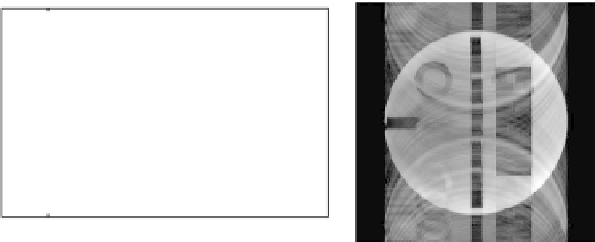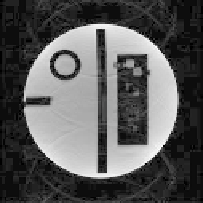Image Processing Reference
In-Depth Information
200
150
100
50
0
10
20
30
40
50
60
Encode count
(a)
(b)
FIGURE 3.15
Non-uniform
4
x
-“exponential” sampling pattern and spatial-domain alias-
ing result.
(and closely related techniques like Generalized SMASH) provides greater flexi-
bility in sub-sampling selection than GRAPPA. One can choose a variety of sub-
sampling patterns, including the exponentially-weighted sampling distribution—
densely sampled in the center of k-space (1x), sparsely sampled at the edges of
k-space (12x), with the change in step size following an exponential decay. —
shown in Figure 3.15. This sub-sampling flexibility allows one to potentially tailor
the sub-sampling choice to particular applications.
On the reconstruction side, SPACE RIP and Generalized SMASH provide a
minimum least-squares error estimate of the image in the same manner as SENSE,
where as GRAPPA provides only at approximate solution in the same manner as
SMASH. The effect of this difference becomes more apparent at high acceleration
factors. For example, Figure 3.16 shows a 4x-acceleration reconstruction for
GRAPPA and SPACE RIP. The GRAPPA reconstruction, in Figure 3.16(a), shows
higher spatial noise throughout the field of view and a significant loss of resolution
in the boxes to the right. In contrast, although the SPACE RIP reconstruction
from identical phase encodes lines in Fig. 3.16(b) shows stronger residual artifacts
(a) GRAPPA (4x hat)
b) SPACE RIP (4x hat)
(c) SPACE RIP (4x exponential)
FIGURE 3.16
Reconstructions of 4
x
-exponential-acceleration data using (a) GRAPPA
and (b) SPACE-RIP.




















































Search WWH ::

Custom Search